Analysis of the Evolution of Drought, Flood, and Drought-Flood Abrupt Alternation Events under Climate Change Using the Daily SWAP Index
Abstract
1. Introduction
2. Study Area and Data
2.1. Study Area: The Hanjiang Basin
2.2. Data
3. Methodology
3.1. Standard Weighted Average Precipitation Index (SWAP)
3.2. Daily Bias Correction
3.3. Event Identification and Characteristics Analysis
3.3.1. The Process of Event Identification
- (1)
- Drought initiation: the interception level of the drought occurrence is −1 (lower limit of a slight drought). When the SWAP value is less than −1 for 10 consecutive days, from a special day, it is defined as a drought event.
- (2)
- Drought end: the interception level of the drought end is 0.5 (upper limit of a near-normal drought). When the SWAP value is more than 0.5 for 7 consecutive days, it is defined as the end of this drought event.
- (3)
- Drought duration: the period of time between the start date and the end date of the drought event.
3.3.2. Data Analysis
4. Results and Discussions
4.1. Robustness of the SWAP Index
4.2. Performance of GCMs in Simulating Regional Precipitation
4.3. Spatio-Temporal Evolution of Drought and Flood Events
4.3.1. The Evolution of Drought and Flood Events in Different Periods
4.3.2. Spatial Analysis of Drought and Flood Events
4.4. Spatio-Temporal Evolution of Drought-flood Abrupt Alternation Events
4.4.1. The Evolution of Drought-flood Abrupt Alternation Events in Different Periods
4.4.2. Spatial Analysis of the Drought-flood Abrupt Alternation Events
5. Conclusions
- SWAP is an effective index for meteorological drought, flood, and drought-flood abrupt alternation events monitoring. It can reliably predict the information of onset, duration, and intensity, and can effectively capture the space–time structure of the events.
- The spatial distribution of the drought frequency has a downward trend in the whole basin, and the flood frequency has a downward trend in the upper reaches and an upward trend in the lower reaches in the reference period (1961–2005). Moreover, the drought frequency of the whole basin may increase in the future period (2021–2095), under the RCP4.5 and RCP8.5 scenarios, but the flood frequency may decrease.
- In the reference period, for the drought-flood abrupt alternation events, the frequency has a downward trend in the upper reaches and an upward trend in the lower reaches, and the spatial distribution of intensity is just opposite to that of frequency. In the future period, the frequency and intensity of the drought-flood abrupt alternation events both show an upward trend in the whole basin under the RCP4.5 and RCP8.5 scenarios.
- The results indicate that droughts will increase due to climate change. At the same time, drought-flood abrupt alternation events will have a higher frequency, and the intensity will be greatly increased in the 21st century, which is likely to pose a major threat to the security of water resources in the Hanjiang basin in the future.
Author Contributions
Funding
Acknowledgments
Conflicts of Interest
References
- Bessah, E.; Raji, A.O.; Taiwo, O.J.; Agodzo, S.K.; Ololade, O.O.; Strapasson, A. Hydrological responses to climate and land use changes: The paradox of regional and local climate effect in the Pra River Basin of Ghana. J. Hydrol. 2020, 27, 100654. [Google Scholar] [CrossRef]
- Sly, W.; Rodrigo, C.; Jhan, C.; Walter, C. Multi-decadal Hydrological Retrospective: Case study of Amazon floods and droughts. J. Hydrol. 2017, 549, 667–684. [Google Scholar]
- Madsen, H.; Lawrence, D.; Lang, M.; Martinkova, M.; Kjeldsen, T. Review of trend analysis and climate change projections of extreme precipitation and floods in Europe. J. Hydrol. 2014, 519, 3634–3650. [Google Scholar] [CrossRef]
- Stephane, H.; Marianne, F.; Edward, B. Disaster Risk, Climate Change, and Poverty: Assessing the Global Exposure of Poor People to Floods and Droughts. Environ. Dev. Econ. 2018, 23, 328–348. [Google Scholar]
- Yin, J.; Guo, S.L.; He, S. A copula-based analysis of projected climate changes to bivariate flood quantiles. J. Hydrol. 2018, 63, 23–42. [Google Scholar] [CrossRef]
- Vivek, G.; Manoj, K. Investigation of Multi-model Spatiotemporal Mesoscale Drought Projections over India under Climate Change Scenario. J. Hydrol. 2018, 567, 489–509. [Google Scholar]
- Dai, A. Increasing drought under global warming in observations and models. Nat. Clim. Chang. 2012, 3, 52–58. [Google Scholar] [CrossRef]
- Leng, G.; Tang, Q.; Rayburg, S. Climate change impacts on meteorological, agricultural and hydrological droughts in China. Glob. Planet. Chang. 2015, 126, 23–34. [Google Scholar] [CrossRef]
- Zhao, C.; Brissette, F.; Chen, J.; Martel, J. Frequency change of future extreme summer meteorological and hydrological droughts over North America. J. Hydrol. 2020, 584, 124316. [Google Scholar] [CrossRef]
- Rahmani, V.; Hutchinson, S.L.; Harrington, J.A.; Hutchinson, J. Analysis of frequency and magnitude of extreme rainfall events with potential impacts on flooding: A case study from the central United States. Int. J. Climatol. 2016, 36, 3578–3587. [Google Scholar] [CrossRef]
- Ma, Y.; Yang, Y.; Wang, C. How essential of the balance between large and small scale features to reproduce precipitation during a sudden sharp turn from drought to flood. Clim. Dyn. 2019, 52, 5013–5029. [Google Scholar] [CrossRef]
- Feng, G.; Yang, H.; Zhang, S.; Wang, K.; Sheng, B. A preliminary research on the reason of a sharp turn from drought to flood in the middle and lower reaches of the Yangtze River in late spring and early summer of 2011. Chin. J. Atmos. Sci. 2012, 36, 1009–1026. [Google Scholar]
- Tian, R.; Cao, C.; Peng, L.; Ma, G.; Bao, D.; Guo, J.; Peera, Y. The use of HJ-1A/B satellite data to detect changes in the size of wetlands in response in to a sudden turn from drought to flood in the middle and lower reaches of the Yangtze River system in China. Geomat. Nat. Hazards Risk 2016, 7, 287–307. [Google Scholar] [CrossRef]
- Shen, B.; Zhang, S.; Yang, H.; Wang, K.; Feng, G. Analysis of characteristics of a sharp turn from drought to flood in the middle and lower reaches of the Yangtze River in spring and summer in 2011. Acta Phys. Sin. 2012, 61, 6. [Google Scholar]
- Zong, H.F.; Cholaw, B.; Chen, L. A typical mode of seasonal circulation transition: A climatic view of the abrupt transition from drought to flood over the middle and lower reaches of the Yangtze River Valley in the late spring and early summer of 2011. Atmos. Ocean. Sci. Lett. 2012, 5, 349–354. [Google Scholar]
- Wu, Z.W.; Li, J.; He, J.; Jiang, Z. Occurrence of droughts and floods during the normal summer monsoons in the mid and lower reaches of the Yangtze River. Geophys. Res. Lett. 2006, 33, L05813. [Google Scholar] [CrossRef]
- Shan, L.J.; Zhang, L.; Song, J.; Zhang, Y.; She, D.; Xia, J. Characteristics of dry-wet abrupt alternation events in the middle and lower reaches of the Yangtze River Basin and the relationship with ENSO. J. Geogr. Sci. 2018, 28, 1039–1058. [Google Scholar] [CrossRef]
- Palmer, W.C. Meteorological Drought, Technique Report no. 45; U.S. Department of Commerce Weather Bureau Research: Washington, DC, USA, 1965. [Google Scholar]
- Mckee, T.B.; Doesken, N.J.; Kleist, J. The relationship of drought frequency and duration to time scales. In Proceedings of the 8th Conference on Applied Climatology, Anaheim, CA, USA, 17–22 January 1993; pp. 179–184. [Google Scholar]
- Wang, M.; Gu, Q.; Jia, X.; Ge, J. An assessment of the impact of Pacific Decadal Oscillation on autumn droughts in North China based on the Palmer drought severity index. Int. J. Climatol. 2019, 39, 5338–5350. [Google Scholar] [CrossRef]
- Wilson, K.; Zhang, J.; Tertsea, I.; Fanan, U.; Obas, J.; Jean, N.; Yao, F. Spatio-temporal analysis of drought and return periods over the East African region using Standardized Precipitation Index from 1920 to 2016. Agric. Water Manag. 2020, 237, 106195. [Google Scholar]
- Smith, D.I.; Hutchinson, M.F.; McArthur, R.J. Australian climate and agricultural drought: Payments and policy. Drought Netw. News 1993, 5, 11–12. [Google Scholar]
- Guttman, N.B. Comparing the Palmer Drought Index and the Standardized Precipitation Index. J. Am. Water Resour. Assoc. 1998, 34, 113–121. [Google Scholar] [CrossRef]
- Sahoo, R.N.; Dutta, D.; Khanna, M.; Kumar, N.; Bandyopadhyay, S.K. Drought assessment in the Dhar and Mewat Districts of India using meteorological, hydrological and remote-sensing derived indices. Nat. Hazards 2015, 77, 733–751. [Google Scholar] [CrossRef]
- Liu, X.; Zhu, X.; Pan, Y.; Bai, J.; Li, S. Performance of different drought indices for agriculture drought in the North China Plain. J. Arid Land 2018, 10, 507–516. [Google Scholar] [CrossRef]
- Lu, E. Determining the start, duration, and strength of flood and drought with daily precipitation: Rationale. Geophys. Res. Lett. 2009, 36. [Google Scholar] [CrossRef]
- Lu, E.; Cai, W.; Jiang, Z.; Zhang, Q.; Cunjie Zhang, C.; Higgins, R.W.; Halpert, M.S. The day-to-day monitoring of the 2011 severe drought in China. Clim. Dynam. 2014, 43, 1–9. [Google Scholar] [CrossRef]
- Lu, E.; Luo, Y.; Zhang, R.; Wu, Q.; Liu, L. Regional atmospheric anomalies responsible for the 2009-2010 severe drought in China. J. Geophys. Res. Atmos. 2011, 116. [Google Scholar] [CrossRef]
- Chen, H.; Xu, C.-Y.; Guo, S. Comparison and evaluation of multiple GCMs, statistical downscaling and hydrological models in the study of climate change impacts on runoff. J. Hydrol. 2012, 434, 36–45. [Google Scholar] [CrossRef]
- Wang, Y.; Wang, D.; Wu, J. Assessing the impact of Danjiangkou reservoir on ecohydrological conditions in Hanjiang river, China. Ecol. Eng. 2015, 81, 41–52. [Google Scholar] [CrossRef]
- Shen, M.; Chen, J.; Zhuan, M.; Chen, H.; Xu, C.Y.; Xiong, L. Estimating uncertainty and its temporal variation related to global climate models in quantifying climate change impacts on hydrology. J. Hydrol. 2017, 556, 10–24. [Google Scholar] [CrossRef]
- Wang, G.; Li, J.; Deng, L.; He, M. China meteorological data sharing service system: Design and development. J. Meteorol. Res. 2004, S1, 10–16. [Google Scholar]
- Taylor, K.E.; Stouffer, R.J.; Meehl, G.A. An Overview of CMIP5 and the Experiment Design. Bull. Am. Meteorol. Soc. 2012, 93, 485–498. [Google Scholar] [CrossRef]
- Yao, N.; Li, L.; Feng, P.; Feng, H.; Liu, D.; Liu, Y.; Jiang, K.; Hu, X.; Li, Y. Projections of drought characteristics in China based on a standardized precipitation and evapotranspiration index and multiple GCMs. Sci. Total Environ. 2020, 704, 135245. [Google Scholar] [CrossRef] [PubMed]
- Sanderson, B.M.; Knutti, R. On the interpretation of constrained climate model ensembles. Geophys. Res. Lett. 2012, 39, 16708. [Google Scholar] [CrossRef]
- National Standard of People’s Republic of China GB/T 20481-2006. In Classification of Meteorological Drought; China Standard Press: Beijing, China, 2006.
- Chen, J.; Brissette, F.P.; Leconte, R. Uncertainty of downscaling method in quantifying the impact of climate change on hydrology. J. Hydrol. 2011, 401, 190–202. [Google Scholar] [CrossRef]
- Chen, J.; Brissette, F.P.; Chaumont, D.; Braun, M. Performance and uncertainty evaluation of empirical downscaling methods in quantifying the climate change impacts on hydrology over two north American river basins. J. Hydrol. 2013, 479, 200–214. [Google Scholar] [CrossRef]
- Mpelasoka, F.S.; Chiew, F.H.S. Influence of rainfall scenario construction methods on runoff projections. J. Hydrometeorol. 2009, 10, 1168–1183. [Google Scholar] [CrossRef]
- Schmidli, J.; Frei, C.; Vidale, P.L. Downscaling from GCM precipitation: A benchmark for dynamical and statistical downscaling methods. Int. J. Climatol. 2006, 26, 679–689. [Google Scholar] [CrossRef]
- Maraun, D. Bias Correction, Quantile Mapping, and Downscaling: Revisiting the Inflation Issue. J. Clim. 2013, 26, 2137–2143. [Google Scholar] [CrossRef]
- Herbst, P.H.; Bredenkamp, D.B.; Barker, H. A technique for the evaluation of drought from rainfall data. J. Hydrol. 1966, 4, 264–272. [Google Scholar] [CrossRef]
- Yevjevich, V. An Objective Approach to Definitions and Investigations of Continental Hydrologic Droughts; Hydrologic Papers; Colorado State University Publisher: Fort Collins, CO, USA, 1967. [Google Scholar]
- Zhang, Q.; Gemmer, M.; Chen, J. Climate changes and flood/drought risk in the Yangtze Delta, China, during the past millennium. Quat. Int. 2008, 176, 62–69. [Google Scholar] [CrossRef]
- He, J.; Yang, X.; Li, Z.; Zhang, X.; Tang, Q. Spatiotemporal Variations of Meteorological Droughts in China during 1961–2014: An Investigation Based on Multi-Threshold Identification. Int. J. Disaster Risk Sci. 2016, 7, 63–76. [Google Scholar] [CrossRef]
- Liu, H.; Wu, J.; Xu, Y. Investigating the Effects of Precipitation on Drought in the Hanjiang River Basin Using SPI. J. Water Clim. Chang. 2019, 10, 977–992. [Google Scholar] [CrossRef]
- Editorial Committee of China Meteorological Disaster Canon. China Meteorological Disaster Canon: Hubei Volume; China Meteorological Press: Beijing, China, 2007; ISBN 9787502943158. [Google Scholar]
- Chen, F.; Liu, C. Estimation of the spatial rainfall distribution using inverse distance weighting (IDW) in the middle of Taiwan. Paddy Water Environ. 2012, 10, 209–222. [Google Scholar] [CrossRef]
- Hayes, M.J.; Svoboda, M.; Wilhite, D.A.; Vanyarkho, O. Monitoring the 1996 drought using the Standardized Precipitation Index. Bull. Am. Meteorol. Soc. 1999, 80, 429–438. [Google Scholar] [CrossRef]
- Mehr, D.; Sorman, K.; Afshar, H. Climate change impacts on meteorological drought using SPI and SPEI: Case study of Ankara, Turkey. Hydrol. Sci. J. 2020, 65, 254–268. [Google Scholar] [CrossRef]
- Tallaksen, L.M.; Stahl, K. Spatial and Temporal Patterns of Large-Scale Droughts in Europe: Model Dispersion and Performance. Geophys. Res. Lett. 2014, 41, 429–434. [Google Scholar] [CrossRef]
- IPCC. Climate Change 2007-The Physical Science Basis: Working Group I Contribution to the Fourth Assessment Report of the IPCC; Cambridge University Press: New York, NY, USA; Volume 4, p. 996. ISBN 9780521705967.
- Garcia, P.; Nicolas, A.; Velazquez, M. Combined use of relative drought indices to analyze climate change impact on meteorological and hydrological droughts in a Mediterranean basin. J. Hydrol. 2017, 554, 292–305. [Google Scholar] [CrossRef]
- Chen, H.; Sun, J. Anthropogenic warming has caused hot droughts more frequently in China. J. Hydrol. 2017, 544, 306–318. [Google Scholar] [CrossRef]
- Her, Y.; Yoo, S.; Cho, J.; Hwang, S.; Jeong, J.; Seong, C. Uncertainty in hydrological analysis of climate change: Multi-parameter vs. multi-GCM ensemble predictions. Sci. Rep. 2019, 9, 4974. [Google Scholar] [CrossRef]
- Chen, J. Overall uncertainty study of the hydrological impacts of climate change for a Canadian watershed. Water Resour. Res. 2011. [Google Scholar] [CrossRef]
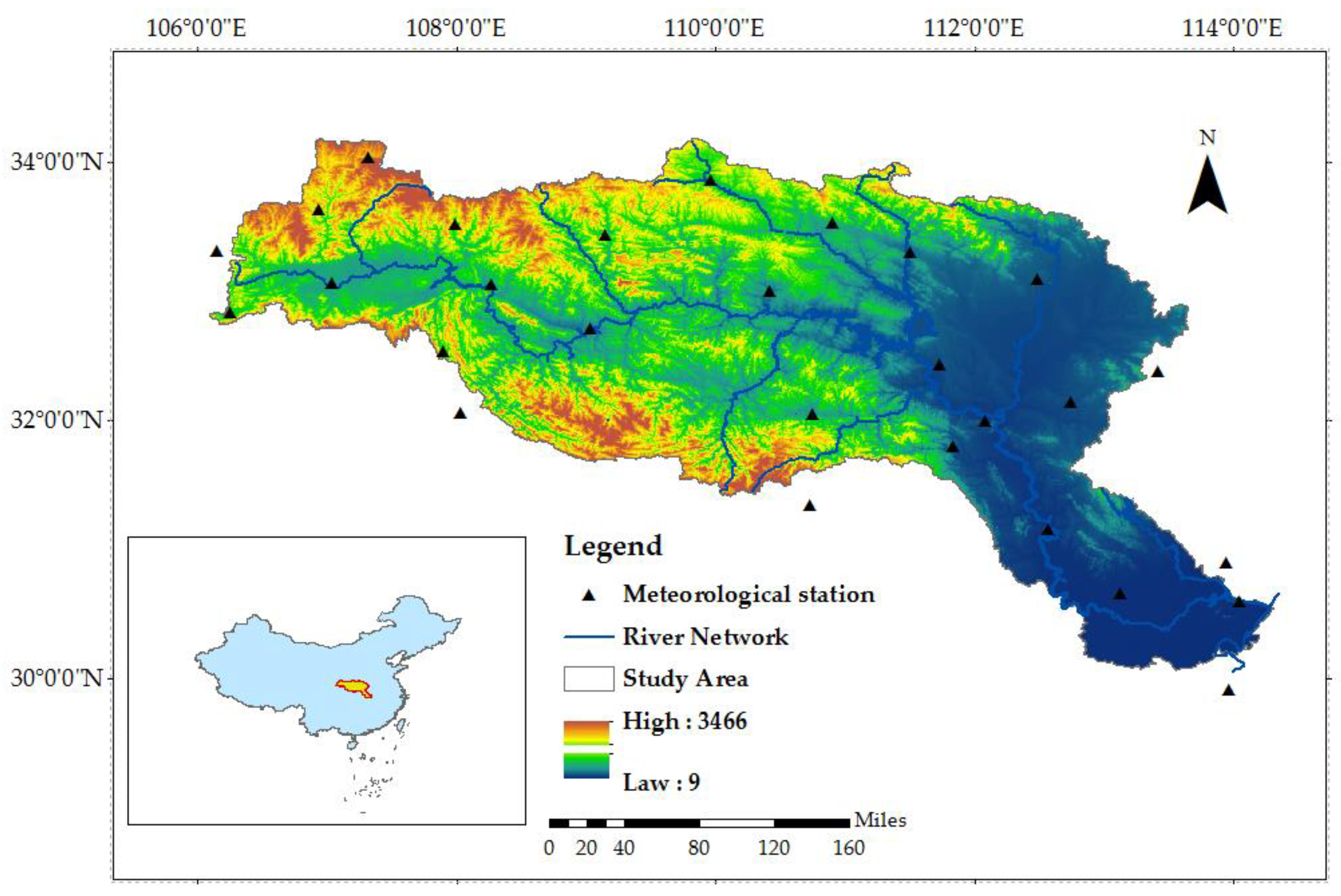

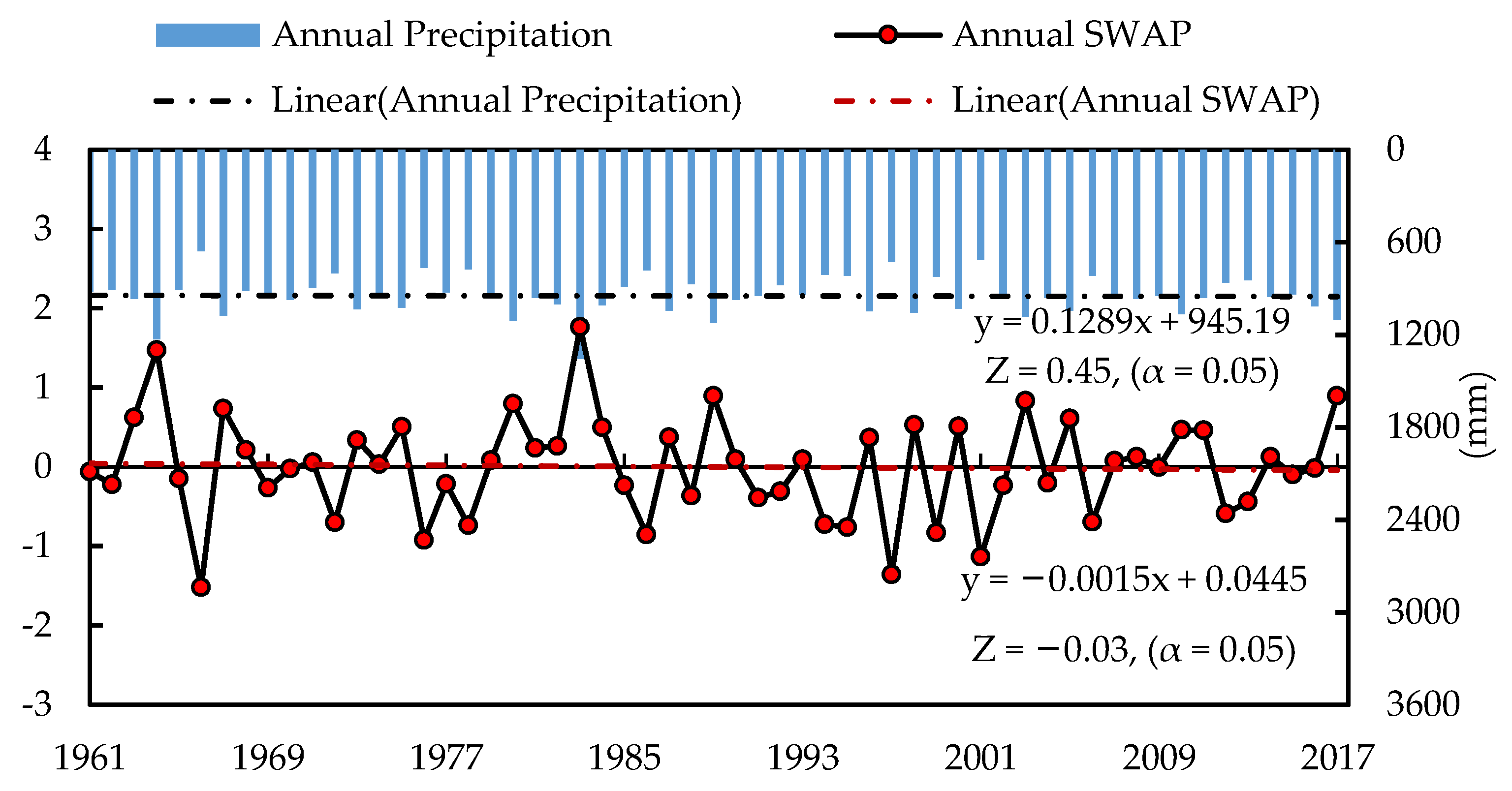
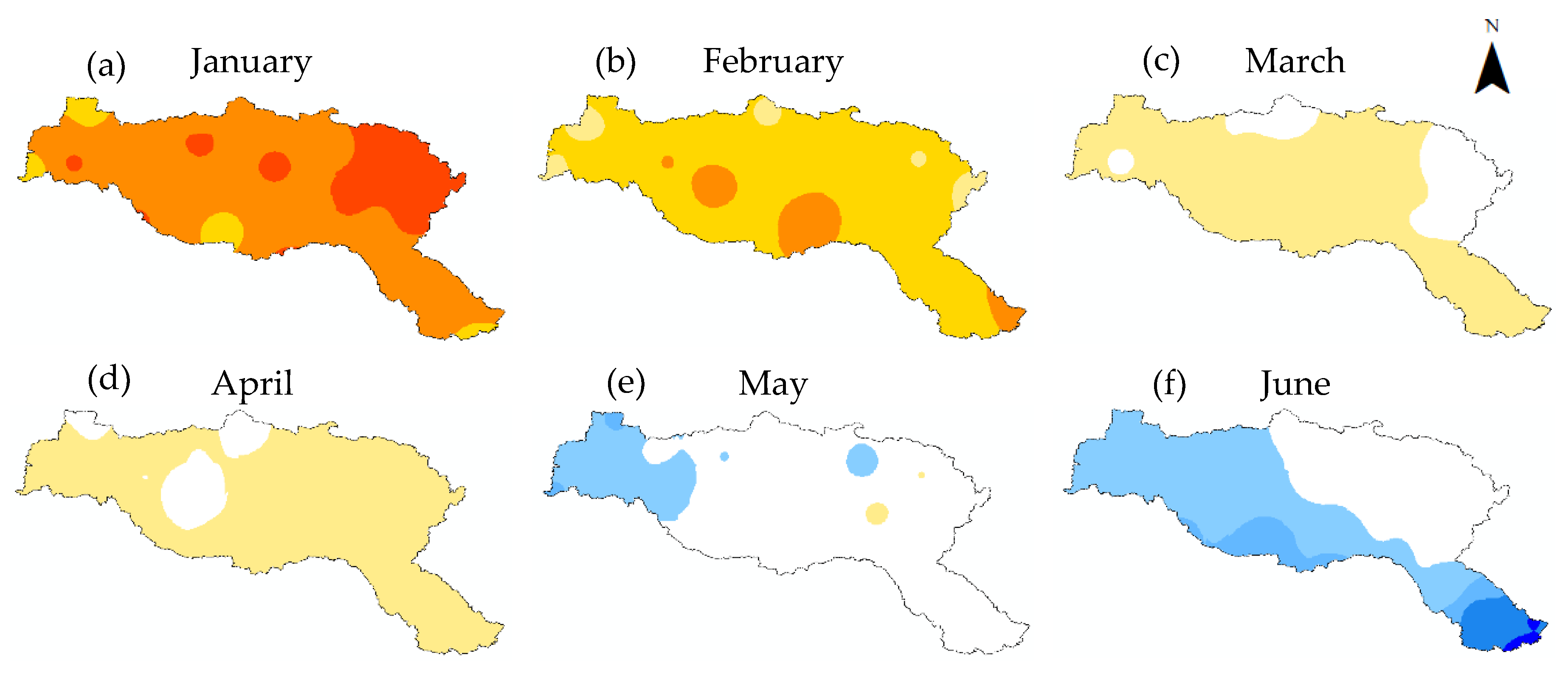
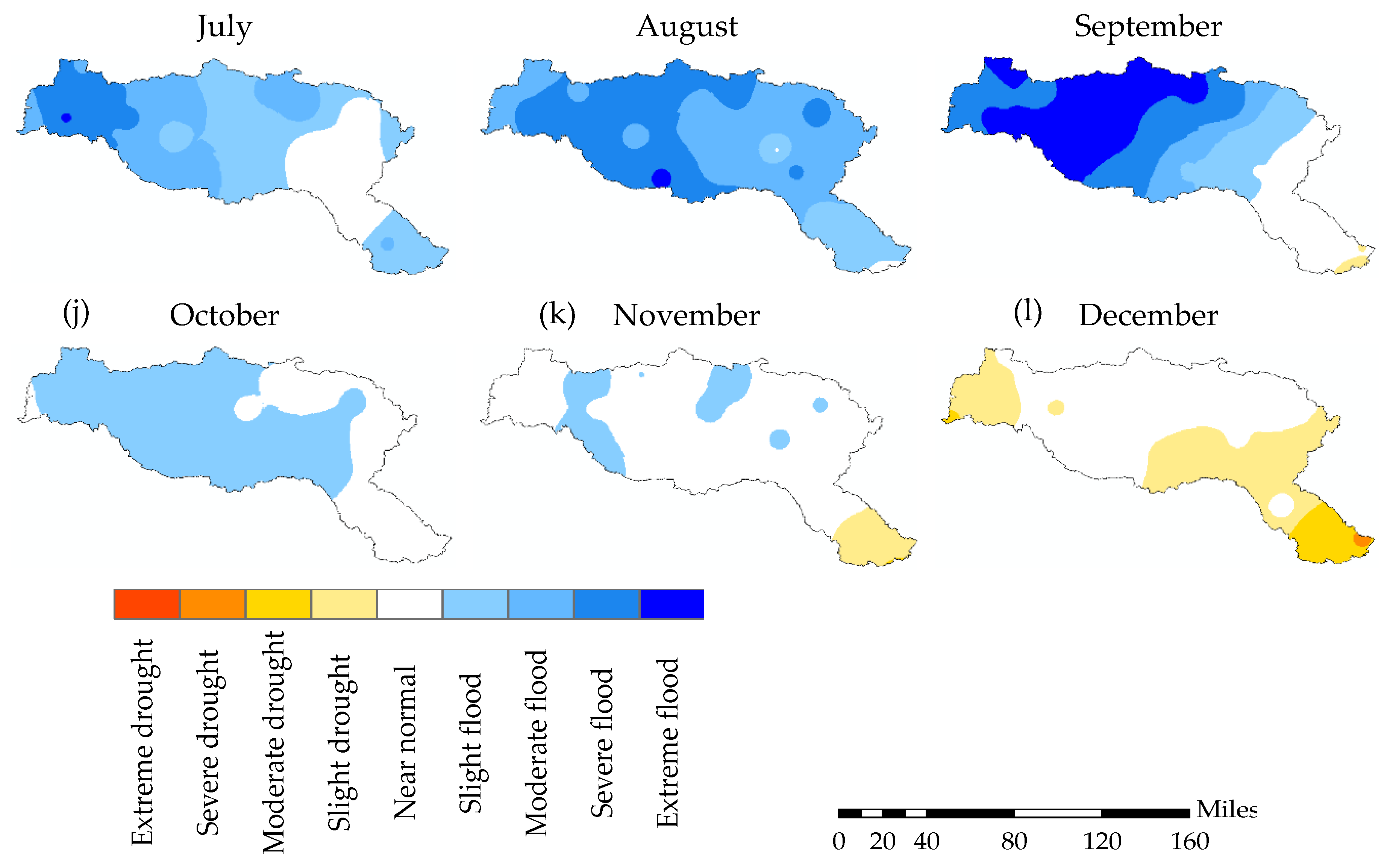
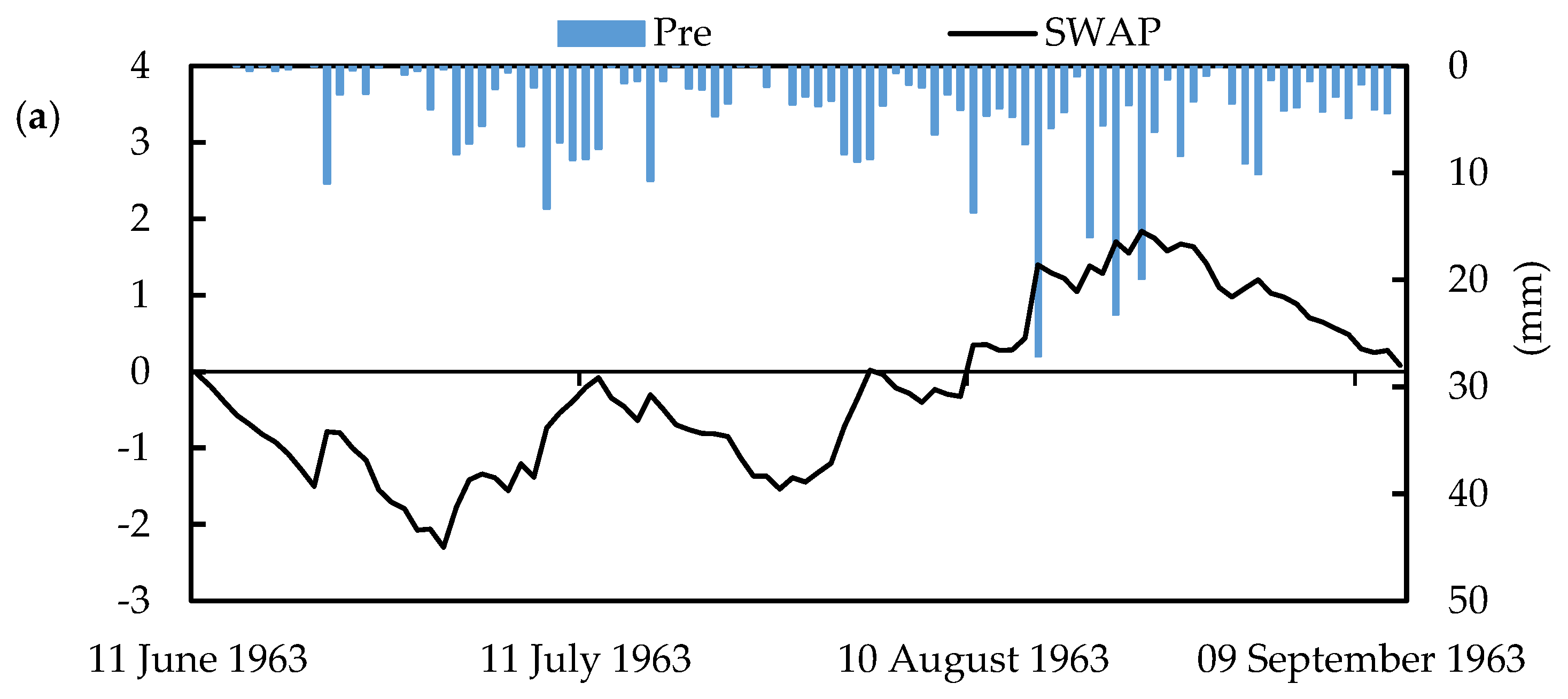
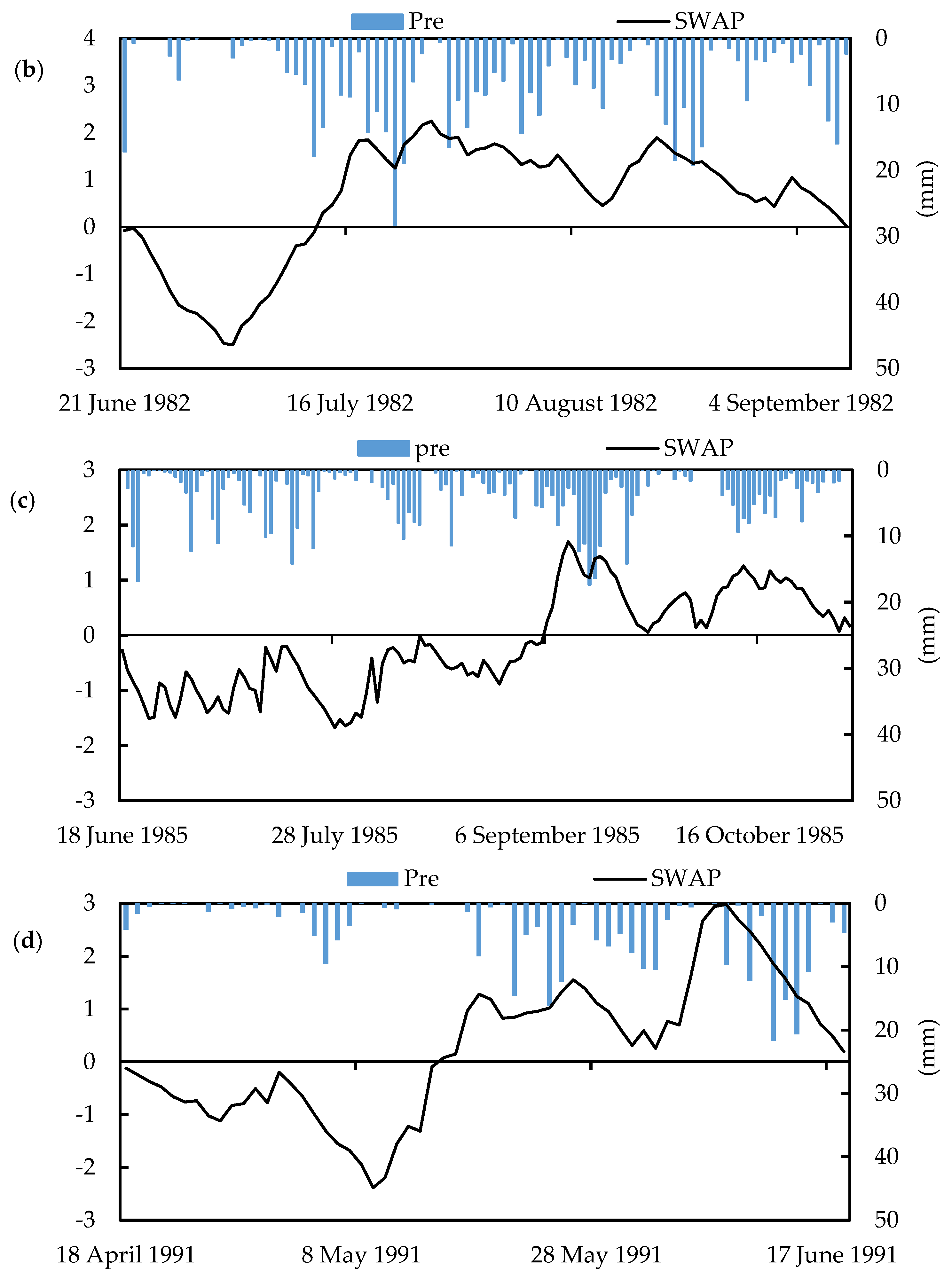

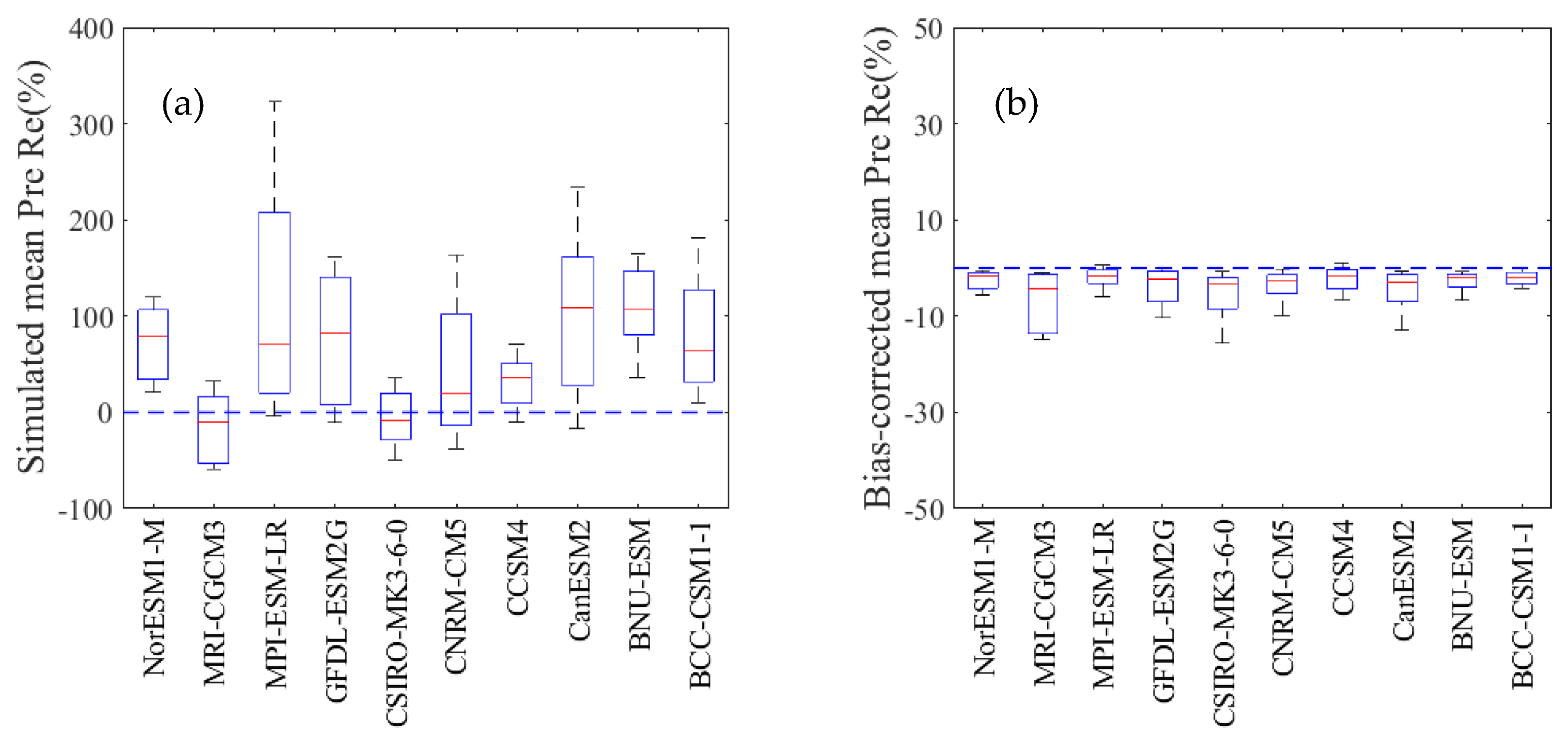
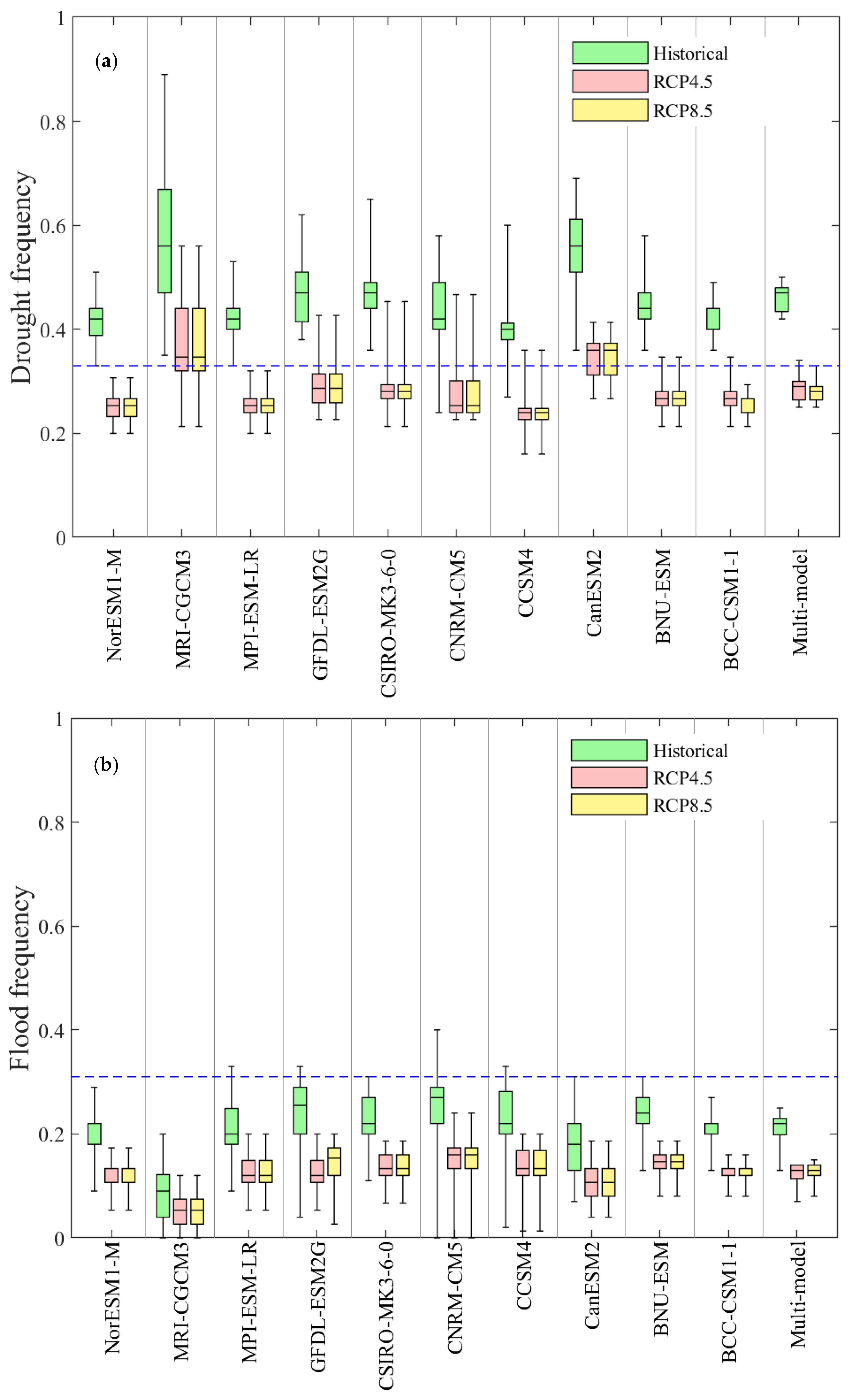


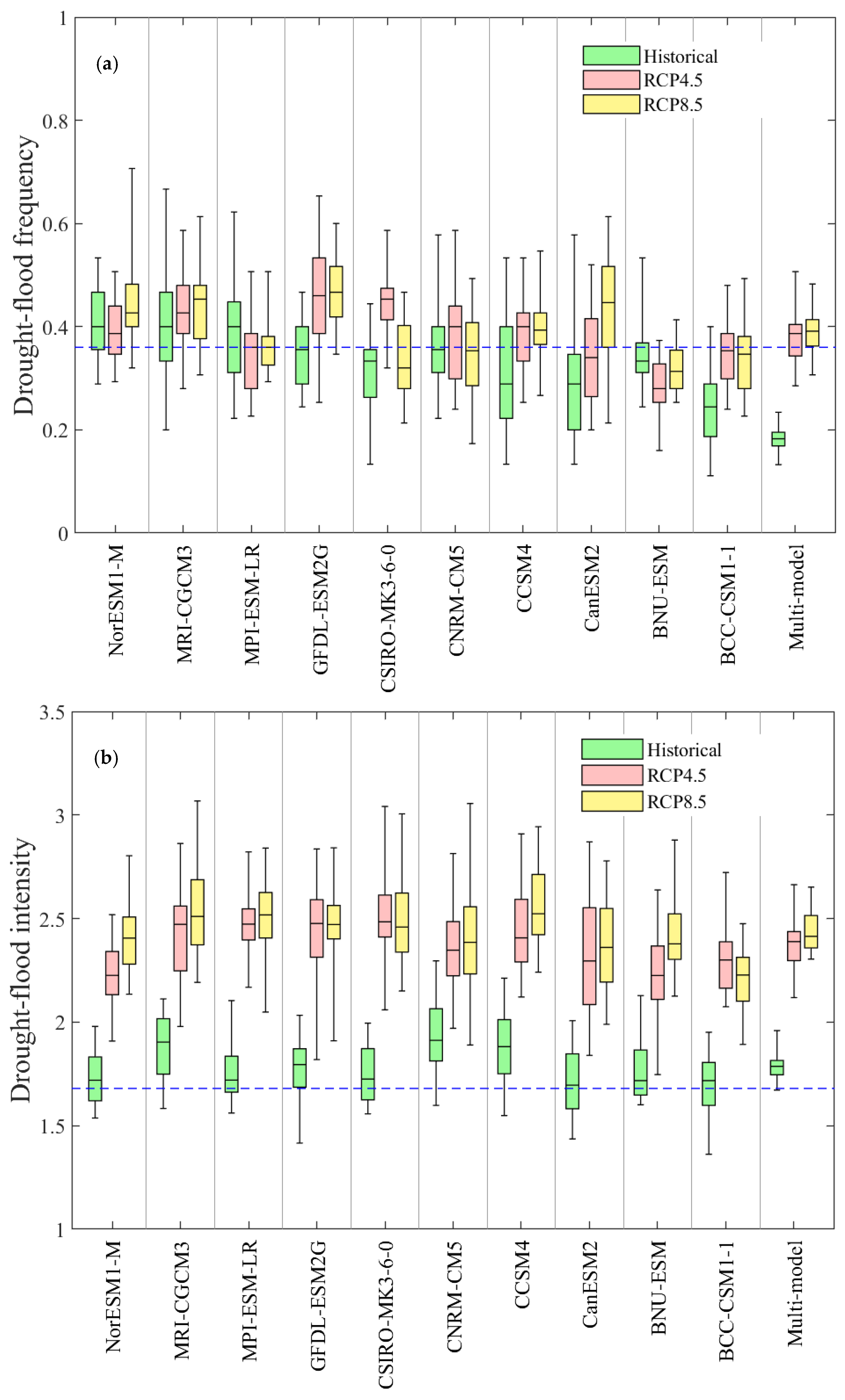
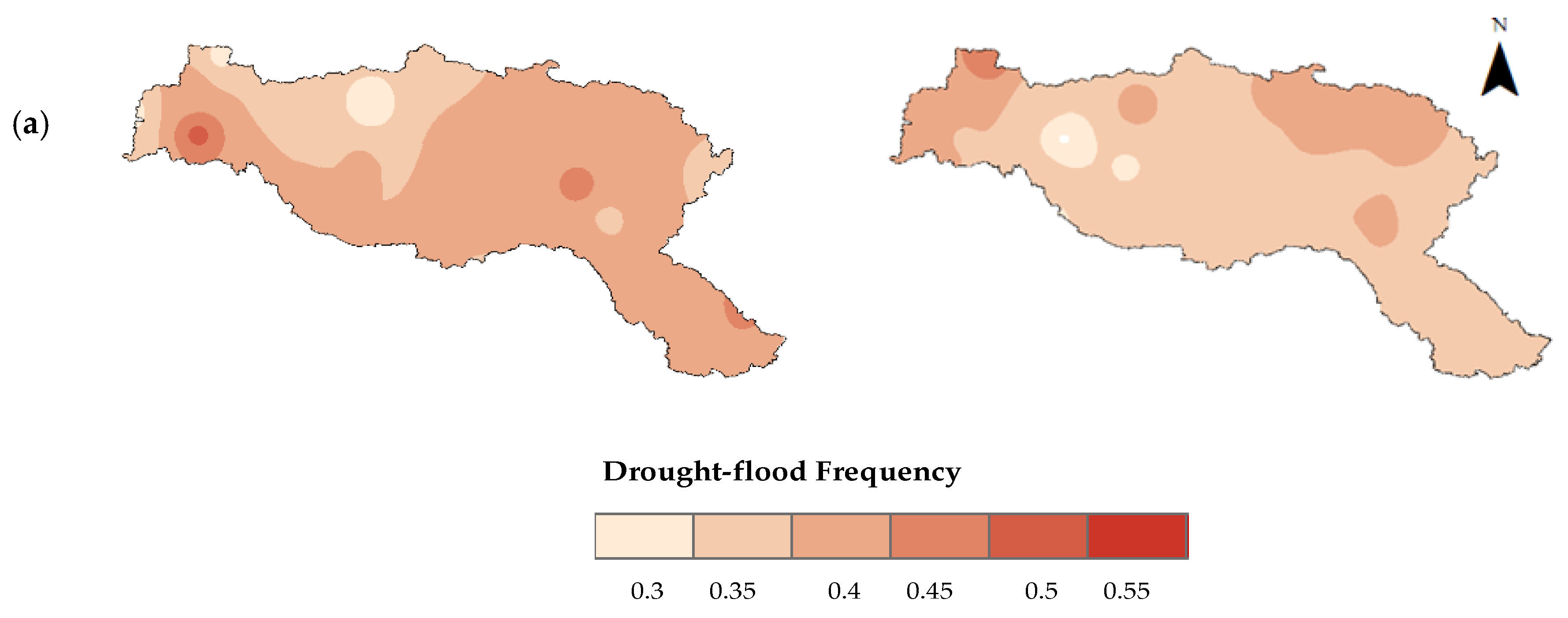
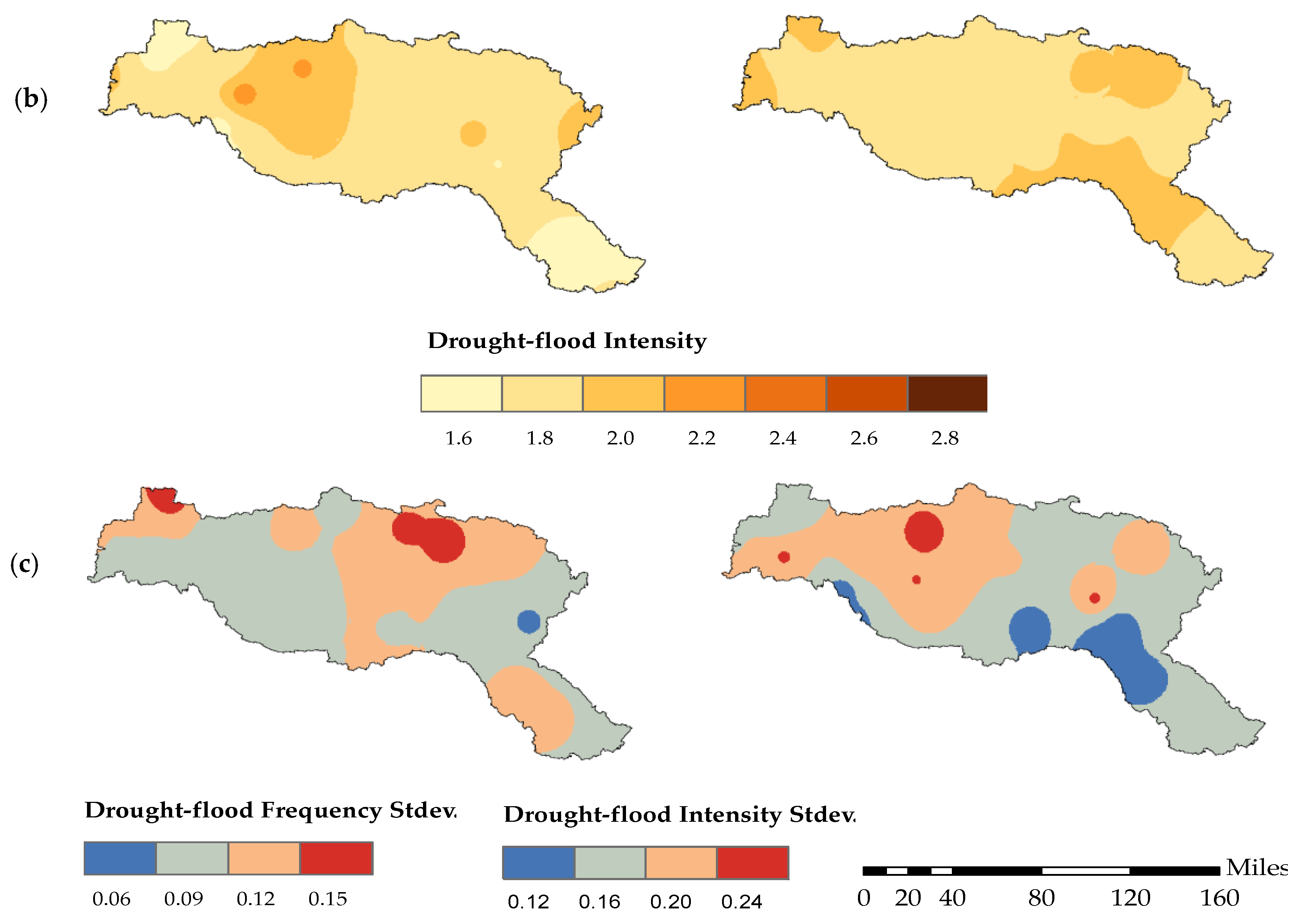

| ID | Model Name | Institution | Country | Horizontal Resolution (Longitude × Latitude) |
|---|---|---|---|---|
| 1 | NorESM1-M | Norwegian Climate Centre | Norway | 1.25° × 0.9° |
| 2 | MRI-CGCM3 | Meteorological Research Institute | Japan | 1.1° × 1.1° |
| 3 | MPI-ESM-LR | Max Planck Institute for Meteorology | Germany | 1.9° × 1.9° |
| 4 | GFDL-ESM2G | Geophysical Fluid Dynamics Laboratory | USA | 2.5° × 2.0° |
| 5 | CSIRO-Mk3-6-0 | Australian Commonwealth Scientific and Industrial Research Organization | Australia | 1.8° × 1.8° |
| 6 | CNRM-CM5 | Centre National de Recherches Meteorologiques, Meteo-France | France | 1.4° × 1.4° |
| 7 | CCSM4 | National Center for Atmospheric Research (NCAR) | USA | 1.25° × 0.9° |
| 8 | CanESM2 | Canadian Centre for Climate Modelling and Analysis | Canada | 2.8° × 2.8° |
| 9 | BNU-ESM | Beijing Normal University | China | 2.8° × 2.8° |
| 10 | BCC-CSM1-1 | Beijing Climate Center, China Meteorological Administration | China | 2.8° × 2.8° |
| Grade | Type | SWAP Value |
|---|---|---|
| −4 | Extreme drought | SWAP ≤ −2.0 |
| −3 | Severe drought | −2.0 < SWAP ≤ −1.5 |
| −2 | Moderate drought | −1.5 < SWAP ≤ −1.0 |
| −1 | Slight drought | −1.0 < SWAP ≤ −0.5 |
| 0 | Near-normal | −0.5 <SWAP < 0.5 |
| 1 | Slight flood | 0.5 ≤ SWAP < 1.0 |
| 2 | Moderate flood | 1.0 ≤ SWAP < 1.5 |
| 3 | Severe flood | 1.5 ≤ SWAP < 2.0 |
| 4 | Extreme flood | 2.0 ≤ SWAP |
| Drought-Flood Intensity | K |
|---|---|
| Severe | 3.0 ≤ K |
| Moderate | 2.0 ≤ K < 3.0 |
| Slight | 1.0 ≤ K < 2.0 |
| Statistics | Emission Scenarios | Observed | NorESM1-M | MRI-CGCM3 | MPI-ESM-LR | GFDL-ESM2G | CSIRO-MK3-6-0 | CNRM-CM5 | CCSM4 | CanESM2 | BNU-ESM | BCC-CSM1-1 | Multi-Model Mean | Standard Deviation |
|---|---|---|---|---|---|---|---|---|---|---|---|---|---|---|
| Frequency | Historical | 0.36 | 0.40 | 0.40 | 0.40 | 0.36 | 0.33 | 0.36 | 0.29 | 0.29 | 0.33 | 0.24 | 0.34 | 0.05 |
| RCP4.5 | 0.39 | 0.43 | 0.35 | 0.46 | 0.44 | 0.38 | 0.38 | 0.34 | 0.28 | 0.35 | 0.38 | 0.05 | ||
| RCP8.5 | 0.45 | 0.44 | 0.37 | 0.47 | 0.34 | 0.35 | 0.40 | 0.43 | 0.32 | 0.34 | 0.39 | 0.05 | ||
| Intensity | Historical | 1.70 | 1.70 | 1.73 | 1.88 | 1.76 | 1.78 | 1.75 | 1.93 | 1.87 | 1.71 | 1.77 | 1.78 | 0.07 |
| RCP4.5 | 2.23 | 2.42 | 2.48 | 2.46 | 2.53 | 2.35 | 2.44 | 2.34 | 2.22 | 2.31 | 2.38 | 0.10 | ||
| RCP8.5 | 2.41 | 2.54 | 2.51 | 2.46 | 2.48 | 2.41 | 2.56 | 2.37 | 2.42 | 2.20 | 2.44 | 0.10 |
© 2020 by the authors. Licensee MDPI, Basel, Switzerland. This article is an open access article distributed under the terms and conditions of the Creative Commons Attribution (CC BY) license (http://creativecommons.org/licenses/by/4.0/).
Share and Cite
Zhao, Y.; Weng, Z.; Chen, H.; Yang, J. Analysis of the Evolution of Drought, Flood, and Drought-Flood Abrupt Alternation Events under Climate Change Using the Daily SWAP Index. Water 2020, 12, 1969. https://doi.org/10.3390/w12071969
Zhao Y, Weng Z, Chen H, Yang J. Analysis of the Evolution of Drought, Flood, and Drought-Flood Abrupt Alternation Events under Climate Change Using the Daily SWAP Index. Water. 2020; 12(7):1969. https://doi.org/10.3390/w12071969
Chicago/Turabian StyleZhao, Ying, Zhaohui Weng, Hua Chen, and Jiawei Yang. 2020. "Analysis of the Evolution of Drought, Flood, and Drought-Flood Abrupt Alternation Events under Climate Change Using the Daily SWAP Index" Water 12, no. 7: 1969. https://doi.org/10.3390/w12071969
APA StyleZhao, Y., Weng, Z., Chen, H., & Yang, J. (2020). Analysis of the Evolution of Drought, Flood, and Drought-Flood Abrupt Alternation Events under Climate Change Using the Daily SWAP Index. Water, 12(7), 1969. https://doi.org/10.3390/w12071969






